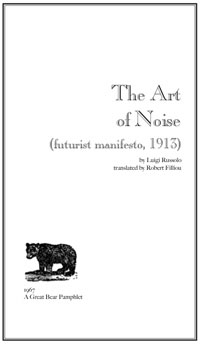

|
 historical historical
 ubuweb ubuweb
|
Luigi Russolo, Italy | 1885-1947 
 The Art of Noise (futurist manifesto, 1913) by Luigi Russolo, translated by Robert Filliou (1967, Great Bear Pamphlet, Something Else Press) [PDF, 1.7mb] The Art of Noise (futurist manifesto, 1913) by Luigi Russolo, translated by Robert Filliou (1967, Great Bear Pamphlet, Something Else Press) [PDF, 1.7mb]
Luigi Russolo (1885-1947) Luigi Russolo was born in Portogruaro (Veneto) in 1885. His father was the local cathedral organist and director of the Schola Cantorum at Latisana. While his two elder brothers graduated from the Milan conservatory, Russolo, after joining his family in Milan in 1901, chose to pursue painting. In 1909 he showed a group of etchings at the Famiglia Artistica in Milan, where he met Boccioni and Carrˆ. His Divisionist period works were influenced by Previati and particularly by Boccioni in style and subject matter. The following year, after his encounter with Marinetti, Russolo signed both the Manifesto of Futurist Painters and the Technical Manifesto of Futurist Painting. Afterwards, he participated in all Futurist soirees and exhibitions. His mature Futurist canvases, while open to Cubist influence, drew primarily on the examples of Anton Giulio Bragaglia's photo-dynamism and Etienne-Jules Marey's chrono-photography. On 11 March 1913, Russolo issued his manifesto L'arte dei rumori (The Art of Noises), dedicated to fellow Futurist composer Francesco Balilla Pratella. Expanded into book form in 1916, it theorized the inclusion of incidental noise into musical composition. With Ugo Piatti, he later invented the intonarumori, noise-emitting machines that allowed the modification of tone and pitch. In 1913-14, Russolo conducted his first Futurist concerts with numerous intonarumori. Audiences in Milan, Genoa and London reacted with enthusiasm or open hostility. Russolo started to contribute to the magazine Lacerba, where in 1914 he published his Grafia enarmonica per gl'intonarumori (Enharmonic Notation for Futurist Intonarumori), which introduced a new and influential form of musical notation. With the outbreak of the war, Russolo volunteered, like many of his Futurist friends, in the Lombard Volunteer Cyclists Battalion. After being seriously wounded in December 1917, he spent eighteen months in various hospitals. In 1921 Russolo held three concerts in Paris with an orchestra of twenty-seven intonarumori. The performances were greatly acclaimed by Stravinsky, Diaghilev (who had already applauded him in Milan in 1915), Ravel and Mondrian, who devoted a long article to the intonarumori in De Stijl. Due to his opposition to Fascism, Russolo spent most of his time between 1927 and 1932 in Paris. Beginning in 1922, he invented a series of rumorarmoni, a kind of harmonium which allowed for the extension of tone and pitch by the simple shift of one register. In 1925 he patented the "enharmonic bow" and later the "enharmonic piano." Russolo appeared in three short Futurist films (now lost), for which he also composed the music. He held his last concert in 1929, presented by Edgard Varese, at the opening of a Futurist show in Paris at the Galerie 23. In 1931 he moved to Tarragona in Spain, where he studied occult philosophy and then in 1933 returned to Italy, settling in Cerro di Laveno on Lake Maggiore. Russolo published his philosophical investigations Al di lˆ della materia (Beyond Matter) in 1938. In 1941-42, he took up painting again in a realist style that he called "classic-modern". Russolo died at Cerro di Lavenio in 1947. Written by Micaela Mantegani |